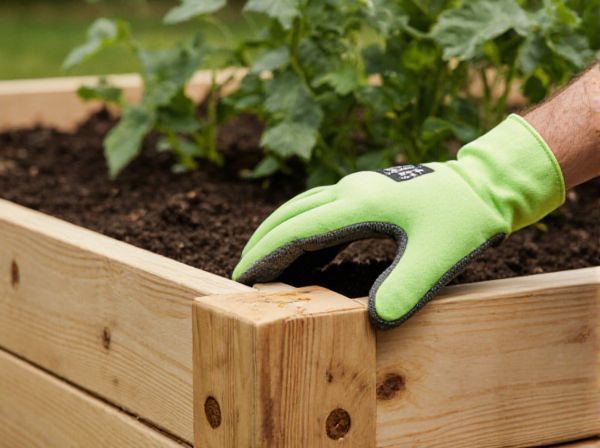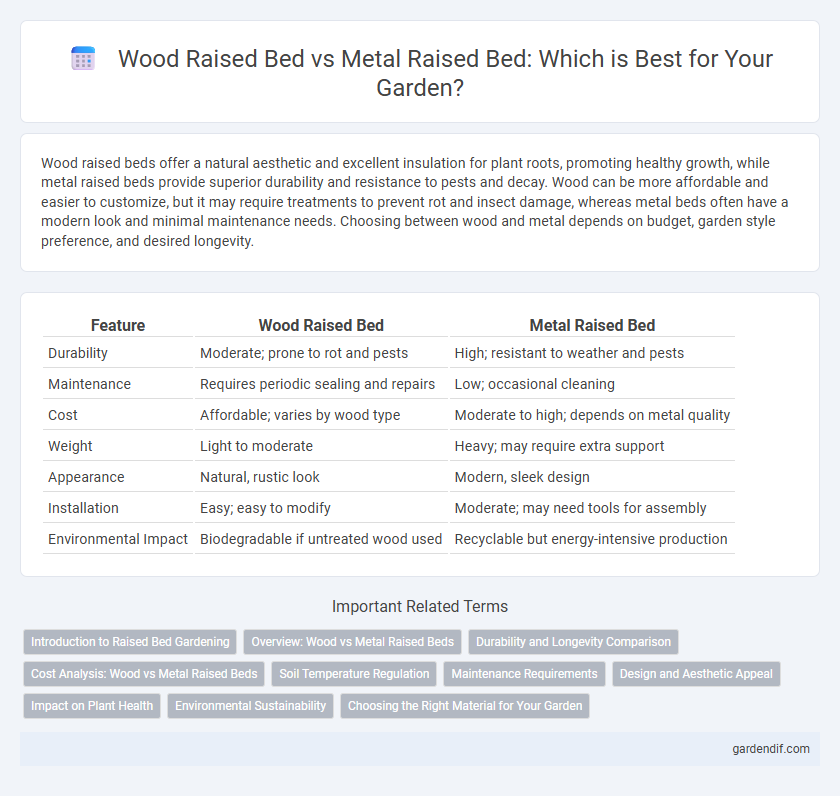
Wood Raised Bed vs Metal Raised Bed Illustration
Wood raised beds offer a natural aesthetic and excellent insulation for plant roots, promoting healthy growth, while metal raised beds provide superior durability and resistance to pests and decay. Wood can be more affordable and easier to customize, but it may require treatments to prevent rot and insect damage, whereas metal beds often have a modern look and minimal maintenance needs. Choosing between wood and metal depends on budget, garden style preference, and desired longevity.
Table of Comparison
| Feature | Wood Raised Bed | Metal Raised Bed |
|---|---|---|
| Durability | Moderate; prone to rot and pests | High; resistant to weather and pests |
| Maintenance | Requires periodic sealing and repairs | Low; occasional cleaning |
| Cost | Affordable; varies by wood type | Moderate to high; depends on metal quality |
| Weight | Light to moderate | Heavy; may require extra support |
| Appearance | Natural, rustic look | Modern, sleek design |
| Installation | Easy; easy to modify | Moderate; may need tools for assembly |
| Environmental Impact | Biodegradable if untreated wood used | Recyclable but energy-intensive production |
Introduction to Raised Bed Gardening
Wood raised beds provide natural insulation, promoting better soil temperature regulation and moisture retention essential for healthy plant growth. Metal raised beds offer durability, resistance to pests, and a longer lifespan, making them ideal for long-term gardening investments. Both materials enhance soil drainage and structure, facilitating efficient root development and higher crop yields in raised bed gardening.
Overview: Wood vs Metal Raised Beds
Wood raised beds offer natural aesthetics, excellent insulation for plant roots, and are typically easier to customize and assemble. Metal raised beds provide superior durability, resistance to pests and rot, and a sleek modern appearance with minimal maintenance. Both options vary in cost, longevity, and environmental impact, influencing the best choice depending on gardening needs and style preferences.
Durability and Longevity Comparison
Wood raised beds offer natural insulation and aesthetic appeal but may suffer from rot, insect damage, and weathering, typically lasting 5 to 10 years depending on wood type and treatment. Metal raised beds, often made from galvanized steel or aluminum, provide superior durability with resistance to rust, warping, and pests, potentially lasting 20 years or more with minimal maintenance. Selecting between wood and metal depends on climate conditions, desired longevity, and maintenance willingness for sustained garden structure performance.
Cost Analysis: Wood vs Metal Raised Beds
Wood raised beds generally cost less upfront, with prices depending on wood type, ranging from $50 to $150 for a standard 4x4-foot bed, while metal raised beds typically start around $100 and can exceed $300 due to material and design variations. Wood may require periodic maintenance or replacement due to rot and insect damage, increasing long-term expenses, whereas metal beds offer greater durability and lower maintenance costs but higher initial investment. Factoring in lifespan and upkeep, metal raised beds often provide better value over time despite higher initial costs compared to wood.
Soil Temperature Regulation
Wood raised beds naturally insulate soil better than metal raised beds, maintaining more stable temperatures critical for root health and plant growth. Metal raised beds tend to heat up faster during the day and cool down rapidly at night, which can cause stress to plants and affect nutrient uptake. Choosing wood for raised beds enhances soil temperature regulation, promoting a more consistent growing environment.
Maintenance Requirements
Wood raised beds typically require regular sealing or staining to prevent rot, insect damage, and weathering, which can extend their lifespan but demands ongoing maintenance. Metal raised beds are resistant to pests and decay, requiring minimal upkeep, though they may need occasional checks for rust or corrosion, especially if made from steel. Both materials benefit from proper installation and climate consideration to reduce maintenance frequency and ensure durability.
Design and Aesthetic Appeal
Wood raised beds offer a natural, rustic aesthetic that blends seamlessly with garden environments, providing warmth and traditional charm. Metal raised beds present a sleek, modern design with clean lines and contemporary appeal, often enhancing minimalist or industrial garden styles. Both materials come in various finishes, allowing customization to suit specific landscape designs and personal taste.
Impact on Plant Health
Wood raised beds naturally regulate soil temperature, providing better insulation that promotes root growth and microbial activity crucial for plant health. Metal raised beds, while durable and resistant to pests, can absorb and radiate heat excessively, potentially stressing plants during hot weather and affecting moisture retention. Choosing wood supports a more stable and conducive environment for nutrient uptake and healthier plant development.
Environmental Sustainability
Wood raised beds made from sustainably sourced, untreated timber offer excellent environmental sustainability due to their biodegradability and lower carbon footprint compared to metal. Metal raised beds, typically produced from steel or aluminum, have a higher environmental impact because of energy-intensive mining and manufacturing processes, though they offer long-term durability and recyclability. Choosing wood raised beds supports sustainable agriculture practices by reducing reliance on non-renewable resources and minimizing greenhouse gas emissions.
Choosing the Right Material for Your Garden
Wood raised beds offer natural insulation, promoting healthy root growth and moisture retention, with options like cedar and redwood providing durability and resistance to rot. Metal raised beds, often made from galvanized steel or aluminum, ensure long-lasting strength, corrosion resistance, and a modern aesthetic ideal for urban gardens. Selecting the right material depends on factors such as climate, desired lifespan, maintenance preferences, and budget considerations to optimize garden productivity.
Wood Raised Bed vs Metal Raised Bed Infographic

 gardendif.com
gardendif.com